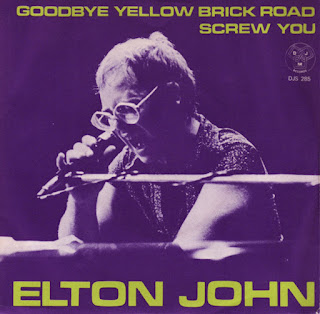ELTON JOHN - GOODBYE YELLOW BRICK ROAD
Publicació: 7 de setembre de 1973 (Regne Unit) 15 d'octubre de 1973 (EUA)
Llistes: Regne Unit: #6 EUA: #2
"Goodbye Yellow Brick Road" llançada el 1973 com a segon senzill de l'àlbum amb el mateix nom, va assolir un notable èxit al entrar en les llistes dels deu primers tant al Regne Unit com als Estats Units. Considerada com una de les grans interpretacions d'Elton John, la cançó ràpidament va superar en popularitat i vendes el seu senzill anterior, "Saturday Night's Alright for Fighting". "Goodbye Yellow Brick Road" és considerada per molts crítics com una de les millors pistes de tota la carrera d'Elton.
"Goodbye Yellow Brick Road" explora el tema d'abandonar una vida d'opulència per una existència més senzilla en un entorn rural. Tot i que Elton John havia experimentat una vida luxosa, la lletra, sovint malinterpretada, incorpora elements autobiogràfics de Bernie Taupin. El lletrista, que preferia una vida més discreta, va prendre inspiració de la seva infància en una granja a Lincolnshire.
La cançó captura el desig de tornar a les arrels i abraçar una vida menys extravagant. La referència al Camí daurat és presa de "El mag d'Oz", on Dorothy i els seus companys emprendran un viatge al llarg del camí daurat a la recerca del màgic Mestre d'Oz, només per adonar-se que allò que buscaven estava dins seu tot el temps. Aquest simbolisme enriqueix el significat de la cançó, posant èmfasi en el tema de la descoberta personal i la cerca d'una vida autèntica i plena.
Bernie Taupin, reflexionant sobre "Goodbye Yellow Brick Road," va compartir idees sobre la creació de la cançó i la seva connexió amb el seu viatge personal. Va expressar un record vívid en certes cançons, però amb "Yellow Brick Road", hi havia una sensació de distància. Taupin va reconèixer una fase de la seva vida en què es sentia atret per la idea de reconnectar amb les seves arrels, inspirant cançons com aquesta.
Durant aquest període, estava contemplat una existència més tranquil·la, tot i que mai va aspirar a rebutjar l'èxit. Taupin creia en trobar un punt mitjà entre l'èxit i un estil de vida més tranquil. Mirant enrere, va reconèixer que aconseguir aquest equilibri requeria navegar per reptes i guanyar experiència. Va concloure expressant gratitud per haver arribat a un punt on podia afirmar "Estic a casa", significant una sensació de satisfacció en el seu viatge personal i creatiu.
ELTON JOHN - GOODBYE YELLOW BRICK ROAD
Released: September 7, 1973 (UK) October 15, 1973 (US)
Charted: UK: #6 US: #2
"Goodbye Yellow Brick Road," released in 1973 as the second single from the album of the same name, achieved notable success by entering the top ten charts in both the United Kingdom and the United States. Regarded as one of Elton John's biggest hits, the song swiftly surpassed the popularity and sales of his preceding single, "Saturday Night's Alright for Fighting”. “Goodbye yellow brick road” is considered by many critics as one of the best in Elton's entire career.
"Goodbye Yellow Brick Road" delves into the theme of forsaking a life of opulence for a simpler existence in a rural setting. While Elton John had experienced a lavish lifestyle, the lyrics, often misconceived, actually incorporate autobiographical elements from Bernie Taupin. Taupin, preferring a more understated life, drew inspiration from his childhood on a farm in Lincolnshire.
The song captures a desire to return to one's roots and embrace a less extravagant life. The reference to the Yellow Brick Road is borrowed from "The Wizard of Oz", where Dorothy and her companions embark on a journey along the yellow brick road in search of the magical Wizard of Oz, only to realize that what they sought was within themselves all along. This symbolism enriches the song's meaning, emphasizing the theme of self-discovery and the pursuit of a genuine and fulfilling life.
Bernie Taupin, reflecting on "Goodbye Yellow Brick Road," shared insights into the song's creation and its connection to his personal journey. He expressed a vivid recollection of certain songs, but for "Yellow Brick Road," there was a sense of detachment. Taupin acknowledged a phase in his life when he was drawn to the idea of reconnecting with his roots, inspiring songs like this one.
During that period, he was contemplating a more tranquil existence, although he never aimed to reject success. Taupin believed in finding a happy medium between success and a calmer lifestyle. Looking back, he recognized that achieving this balance required navigating challenges and gaining experience. He concluded by expressing gratitude for having reached a point where he could assert, "I am home," signifying a sense of fulfillment in his personal and creative journey.











Cap comentari:
Publica un comentari a l'entrada